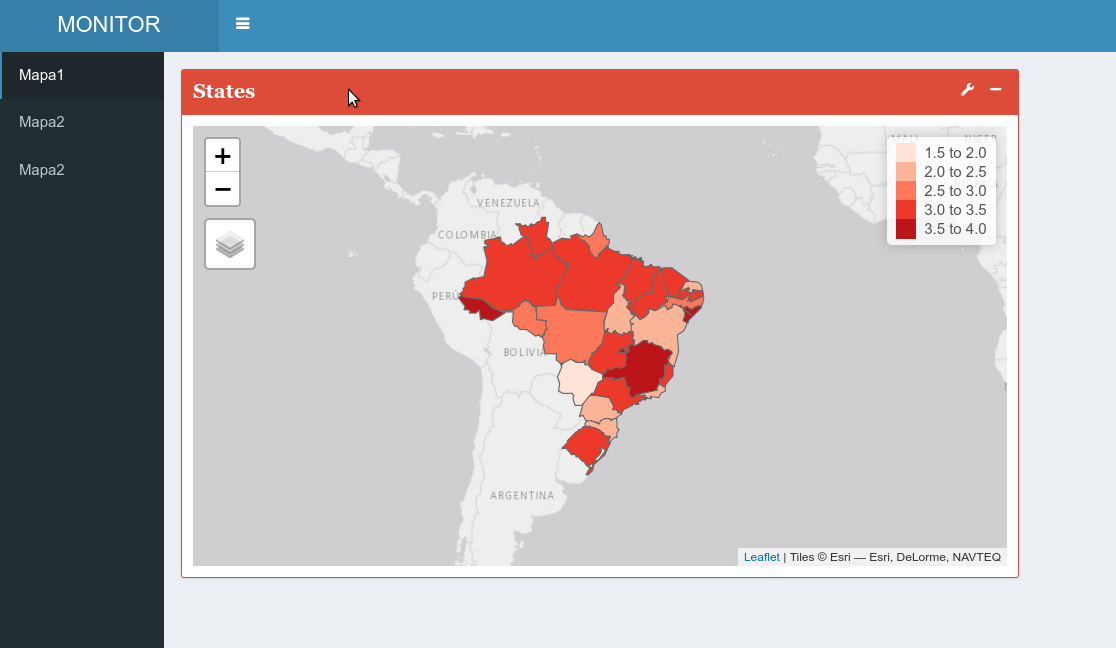0
I am working on a Shiny app and would like the map to be rendered according to the user’s choice in a dropdown. I have three maps (M1, m2 and m3), what I need to put on the ui and server?
Follows a reproducible excerpt:
## Options ##
options("scipen"=20)
## Pacotes ##
library(shiny)
library(shinydashboard)
library(shinydashboardPlus)
library(shinyWidgets)
library(plotly)
library(ggplot2)
library(openxlsx)
library(sf)
library(tmap)
library(dplyr)
library(leaflet)
library(BETS)
## Maps ##
# States
map<-st_read("./Brasil/UFEBRASIL.shp", stringsAsFactors = FALSE)
IST<-BETSget(
c(15925, 15926, 15927, 15928, 15929,
15930, 15931, 15932, 15933, 15934,
15935, 15936, 15937, 15938, 15939,
15940, 15941, 15942, 15943, 15944,
15945, 15946, 15947, 15948, 15949,
15950, 15951),
data.frame = TRUE)
IST1<-BETSget(
c(15861, 15862, 15863, 15864, 15865,
15866, 15867, 15868, 15869, 15870,
15871, 15872, 15873, 15874, 15875,
15876, 15877, 15878, 15879, 15880,
15881, 15882, 15883, 15884, 15885,
15886, 15887),
data.frame = TRUE)
IST2<-BETSget(
c(15893, 15894, 15895, 15896, 15897,
15898, 15899, 15900, 15901, 15902,
15903, 15904, 15905, 15906, 15907,
15908, 15909, 15910, 15911, 15912,
15913, 15914, 15915, 15916, 15917,
15918, 15919),
data.frame = TRUE)
names(IST)<-States
names(IST1)<-States
names(IST2)<-States
IST<-lapply(IST, tail, 1)
INST1<-lapply(IST1, tail, 1)
IST2<-lapply(IST2, tail, 1)
Estados<-c("ACRE",
"ALAGOAS",
"AMAPÁ",
"AMAZONAS",
"BAHIA",
"CEARÁ",
"DISTRITO FEDERAL",
"ESPIRITO SANTO",
"GOIÁS",
"MARANHÃO",
"MATO GROSSO",
"MATO GROSSO DO SUL",
"MINAS GERAIS",
"PARÁ",
"PARAÍBA",
"PARANÁ",
"PERNAMBUCO",
"PIAUÍ",
"RIO DE JANEIRO",
"RIO GRANDE DO NORTE",
"RIO GRANDE DO SUL",
"RONDÔNIA",
"RORAIMA",
"SANTA CATARINA",
"SÃO PAULO",
"SERGIPE",
"TOCANTINS"
)
IST<-data.frame(States = States,
I = c(IST$`ACRE`$value,
IST$`ALAGOAS`$value,
IST$`AMAPÁ`$value,
IST$`AMAZONAS`$value,
IST$`BAHIA`$value,
IST$`CEARÁ`$value,
IST$`DISTRITO FEDERAL`$value,
IST$`ESPIRITO SANTO`$value,
IST$`GOIÁS`$value,
IST$`MARANHÃO`$value,
IST$`MATO GROSSO`$value,
IST$`MATO GROSSO DO SUL`$value,
IST$`MINAS GERAIS`$value,
IST$`PARÁ`$value,
IST$`PARAÍBA`$value,
IST$`PARANÁ`$value,
IST$`PERNAMBUCO`$value,
IST$`PIAUÍ`$value,
IST$`RIO DE JANEIRO`$value,
IST$`RIO GRANDE DO NORTE`$value,
IST$`RIO GRANDE DO SUL`$value,
IST$`RONDÔNIA`$value,
IST$`RORAIMA`$value,
IST$`SANTA CATARINA`$value,
IST$`SÃO PAULO`$value,
IST$`SERGIPE`$value,
IST$`TOCANTINS`$value)
)
IST1<-data.frame(States = States,
I = c(IST1$`ACRE`$value,
IST1$`ALAGOAS`$value,
IST1$`AMAPÁ`$value,
IST1$`AMAZONAS`$value,
IST1$`BAHIA`$value,
IST1$`CEARÁ`$value,
IST1$`DISTRITO FEDERAL`$value,
IST1$`ESPIRITO SANTO`$value,
IST1$`GOIÁS`$value,
IST1$`MARANHÃO`$value,
IST1$`MATO GROSSO`$value,
IST1$`MATO GROSSO DO SUL`$value,
IST1$`MINAS GERAIS`$value,
IST1$`PARÁ`$value,
IST1$`PARAÍBA`$value,
IST1$`PARANÁ`$value,
IST1$`PERNAMBUCO`$value,
IST1$`PIAUÍ`$value,
IST1$`RIO DE JANEIRO`$value,
IST1$`RIO GRANDE DO NORTE`$value,
IST1$`RIO GRANDE DO SUL`$value,
IST1$`RONDÔNIA`$value,
IST1$`RORAIMA`$value,
IST1$`SANTA CATARINA`$value,
IST1$`SÃO PAULO`$value,
IST1$`SERGIPE`$value,
IST1$`TOCANTINS`$value)
)
IST2<-data.frame(States = States,
I = c(IST2$`ACRE`$value,
IST2$`ALAGOAS`$value,
IST2$`AMAPÁ`$value,
IST2$`AMAZONAS`$value,
IST2$`BAHIA`$value,
IST2$`CEARÁ`$value,
IST2$`DISTRITO FEDERAL`$value,
IST2$`ESPIRITO SANTO`$value,
IST2$`GOIÁS`$value,
IST2$`MARANHÃO`$value,
IST2$`MATO GROSSO`$value,
IST2$`MATO GROSSO DO SUL`$value,
IST2$`MINAS GERAIS`$value,
IST2$`PARÁ`$value,
IST2$`PARAÍBA`$value,
IST2$`PARANÁ`$value,
IST2$`PERNAMBUCO`$value,
IST2$`PIAUÍ`$value,
IST2$`RIO DE JANEIRO`$value,
IST2$`RIO GRANDE DO NORTE`$value,
IST2$`RIO GRANDE DO SUL`$value,
IST2$`RONDÔNIA`$value,
IST2$`RORAIMA`$value,
IST2$`SANTA CATARINA`$value,
IST2$`SÃO PAULO`$value,
IST2$`SERGIPE`$value,
IST2$`TOCANTINS`$value)
)
Boxm1<-
boxPlus(
title = tags$b("States", style = 'font-family: "Georgia"'),
closable = FALSE,
width = 6,
status = "danger",
solidHeader = TRUE,
collapsible = TRUE,
enable_dropdown = TRUE,
dropdown_menu = dropdownItemList(), # What should i do here?
leafletOutput("m1"), # What should i do here?
footer = NULL
)
## User Interface ##
header <- dashboardHeaderPlus(title = "MONITOR",
titleWidth = 200
)
sidebar <- dashboardSidebar(
width = 150,
sidebarMenu(
menuItem("Maps", tabName = "maps", icon = icon("globe-americas", lib = "font-awesome"))
)
)
body <- dashboardBody(
tabItems(
# Maps
tabItem(tabName = "maps",
fluidRow(
Boxm1 # Maps
)
)
)
)
ui <- dashboardPagePlus(header, sidebar, body)
server <- function(input, output) {
output$m1<-renderLeaflet({
tmap_mode("view")
IST<-inner_join(map, IST, by = c("NM_ESTADO" = "States"))
IST<-IST[, c(3,1,2,4,5,6)]
m1<-tm_shape(IST, name = "Maps") +
tm_polygons("I", palette = "Reds", title = "")
tmap_leaflet(m1)
})
output$m2<-renderLeaflet({
tmap_mode("view")
IST1<-inner_join(map, IST1, by = c("NM_ESTADO" = "States"))
IST1<-IST1[, c(3,1,2,4,5,6)]
m2<-tm_shape(IST1, name = "Maps") +
tm_polygons("I", palette = "Reds", title = "")
tmap_leaflet(m2)
})
output$m3<-renderLeaflet({
tmap_mode("view")
IST2<-inner_join(map, IST2, by = c("NM_ESTADO" = "States"))
IST2<-IST2[, c(3,1,2,4,5,6)]
m3<-tm_shape(IST2, name = "Maps") +
tm_polygons("I", palette = "Reds", title = "")
tmap_leaflet(m3)
})
}
## App ##
shinyApp(ui, server)

just put the
leafletOutput()within thebody. You have to wear the sameids that were used in the server.– Tomás Barcellos
Welcome to Sopt! Here are some tips on how to improve your question here
– Tomás Barcellos